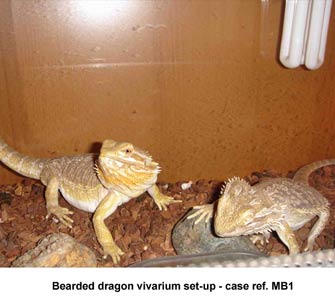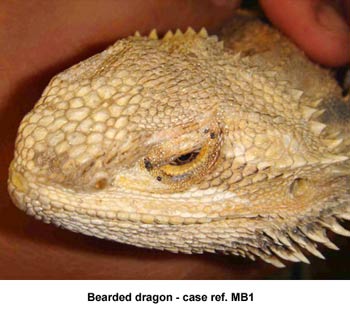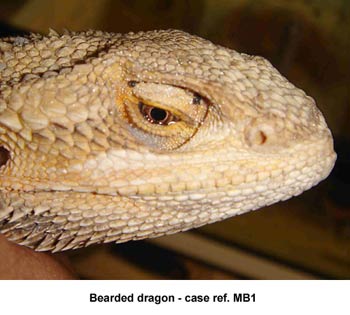|
|
This
is one case from a series of reports compiled as part
of an investigation into photo-kerato-conjunctivitis,
possibly occurring as a result of excessive low-wavelength
UVB radiation under certain brands of fluorescent
UVB lamp.
Please
do not view this one case without reference to the
whole report of which it is a part.
|
Case
History : MB1
(Italy) - Bearded dragons (Pogona
vitticeps)
Cases
examined by Michele Buono DVM (Turin, Italy)
|
Two
subadult bearded dragons (Pogona vitticeps),
one male and one female aged 1 year, were housed in
a new enclosure, size approximately 80cm by 40cm by
40cm. (31.5in by 16in by 16in.) in April 2007.
The
new enclosure was furnished simply with bark chips
as substrate, a piece of cork, and two dishes for
food and water. A new ZooMed Reptisun 10.0 Compact
Lamp was installed vertically inside the vivarium,
affixed to the ceiling at one end, with no reflector
or hood. The lamp was on for 12 hours a day. The distance
from the lamp to the reptiles was only about 15cm.
(6 in.) (Figure 1)
After
5 days the two animals became inappetent, static,
and spent all the day with their eyes closed. After
7 days they completely stopped eating, and light swelling
of the eyelids, especially the lower lids, was noticed.
(Figures 2 and 3, below)
|
 |
 |
 |
The
new lamp was removed and replaced by a regular household
spot lamp.
After
4 to 5 days the eyelid swelling had disappeared, but the
animals remained abnormally quiet with their eyes closed.
When stimulated, they could be aroused and they began to
eat.
After
7 to 10 days they were normal, active and their appetite
was restored.
|




















